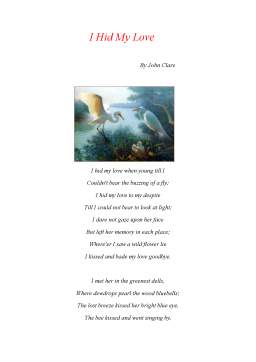Extras din referat
John Clare was born on 13 July 1973, in Helpson, a place in ”Sketches” in the ”Life of John Clare, written in 1821, as ”gloomy village in Northamptonshire, on the brink of the Lincolnshire fens”. He was the son of Parker Clare, a barely literate casual farm worker and his mother, Ann Stimson, an illiterate, though as she said she experienced enough in her own case to avoid bringing up her children in ignorance and did what she could to make their son John a good scholar.
Clare was the eldest of four children, two of whom, including his twin sister, died in infancy, and his childhood and early life were spent in the tough and near-destitute conditions of the rural poor.
By the age of ten, Clare was working with his father for the scanty rewards of industry. At the age of twelve, Clare befriended Mary Joyce, a local farmer’s daughter, at school in Glinton, and though their reletionship ended around 1816, her memory was to haunt him for the rest of his life. His adolescence years, by his own later accounts, were passed eking out a living doing a combination of precarious, temporary labouring jobs doing a combinaion of precarious, temporary labouring jobs, from time-burning to hedging and ditching during enclosure of local land.
Between 1810 and 1816, he worked at a variety of casual jobs in the Helpston area including brief spells as militia recruit, gang labourer, harvester and asistant in the kitchen garden at Burghley House near Stamford. Despite living and working during this period as a casual agricultural hand like others of his class and place, he simultaneously pursued, from an early age, a highly unusual obsession with reading and writing poetry.
Clare anxious to conceal his scribbling, was with all secresy possible, taking off from work whatever time he could find to write verse on whatever scraps of paper he could get hold of. At first, the only audience he found for his experiments in poetry was his parents. Pretending, by a strategy of inverse plagiarism, that what he was reading had been written by other people. His almost illiterate parents were his first critics an he claims to have found their criticism useful. In time he built up a body of work and cautiously approached people outside the family, and in 1817 his proposal for publishing a volume of his poems by subscription caught the attention of Edward Drury, a Stamford bookseller who was the cousin of the London publisher John Taylor.
Clare consequently met Taylor in 1819, who published his first volume of poems ”Poems Descriptive of Rural Life and Scenery” in 1820, the title page which described the author as a ” Northamptonshire Peasant”. Within a year Clare’s first book had sold over 3,000 copies and by 1821 it had gone ino four editions, a phenomenal succes for a firs volume of poems by a completly unknown poet. 1820 was a momentous year for Clare in other respects too. He married Martha Patty Turner and made his first journeyl to London, where he met, among others, his future patron, Eliza Emmerson, and his friend, the painter Edward Rippingille. At this time, the labourer from Helpston must have seemed on the verge of a successful literaryy career.
Clare was constantly torn between the two worlds of literary London and his often illiterate neighbours; between the need to write poetry and the need for money to feed and clothe his children. His health began to suffer, and he had bouts of severe depression, which became worse after his sixth child was born in 1830 and as his poetry sold less well. In 1832, his friends and his London patrons clubbed together to move the family to a larger cottage with a smallholding in the village of Northborough, not far from Helpston. However, he felt only more alienated.
His last work, the Rural Muse (1835), was noticed favourably by Christopher North and other reviewers, but this was not enough to support his wife and seven children. Clare's mental health began to worsen. As his alcohol consumption steadily increased along with his dissatisfaction with his own identity, Clare's behaviour became more erratic. He was becoming a burden to Patty and his family, and in July 1837, on the recommendation of his publishing friend, John Taylor, Clare went of his own volition (accompanied by a friend of Taylor's) to Dr Matthew Allen's private asylum High Beach near Loughton, in Epping Forest. Taylor had assured Clare that he would receive the best medical care.
Preview document
Conținut arhivă zip
- John Clare.docx


















